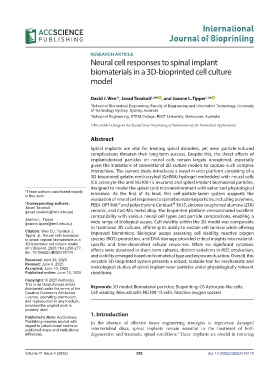Page 264 - v11i4
P. 264
International
Journal of Bioprinting
RESEARCH ARTICLE
Neural cell responses to spinal implant
biomaterials in a 3D-bioprinted cell culture
model
* , and Joanne L. Tipper *
David J. Wen , Javad Tavakoli 1,2† id 1,2 id
1†
1 School of Biomedical Engineering, Faculty of Engineering and Information Technology, University
of Technology Sydney, Sydney, Australia
2 School of Engineering, STEM College, RMIT University, Melbourne, Australia
(This article belongs to the Special Issue: Bioprinting of Nanomaterials for Biomedical Applications)
Abstract
Spinal implants are vital for treating spinal disorders, yet wear particle-induced
complications threaten their long-term success. Despite this, the direct effects of
implant-derived particles on neural cells remain largely unexplored, especially
given the limitations of conventional 2D culture models to capture such complex
interactions. The current study introduces a novel in vitro platform consisting of a
3D-bioprinted gelatin methacryloyl (GelMA) hydrogel embedded with neural cells
(C6 astrocyte-like and NG108-15 neurons) and spinal implant biomaterial particles,
designed to model the spinal cord microenvironment with enhanced physiological
† These authors contributed equally relevance. As the first of its kind, this cell-particle-laden system supports the
to this work.
evaluation of neural cell responses to spinal biomaterial particles, including polymers,
®
*Corresponding authors: PEEK-OPTIMA™ and polyethylene Ceridust 3615, zirconia-toughened alumina (ZTA)
Javad Tavakoli
(javad.tavakoli@rmit.edu.au) ceramic, and CoCrMo metal alloy. The bioprinted platform demonstrated excellent
compatibility with various neural cell types and particle compositions, enabling a
Joanne L. Tipper
(joanne.tipper@rmit.edu.au) wide range of biological assays. Cell viability within the 3D model was comparable
to traditional 2D cultures, affirming its ability to sustain cell survival while offering
Citation: Wen DJ, Tavakoli J, improved biomimicry. Biological assays assessing cell viability, reactive oxygen
Tipper JL. Neural cell responses
to spinal implant biomaterials in a species (ROS) production, and DNA damage provided critical insights into material-
3D-bioprinted cell culture model. specific and time-dependent cellular responses. While no significant cytotoxic
Int J Bioprint. 2025;11(4):256-277. effects were observed in short-term cultures, distinct variations in ROS production,
doi: 10.36922/IJB025180174
and viability emerged based on biomaterial type and exposure duration. Overall, this
Received: April 29, 2025 versatile 3D-bioprinted system presents a robust, scalable tool for mechanistic and
Revised: June 4, 2025
Accepted: June 10, 2025 toxicological studies of spinal implant wear particles under physiologically relevant
Published online: June 10, 2025 conditions.
Copyright: © 2025 Author(s).
This is an Open Access article
distributed under the terms of the Keywords: 3D model; Biomaterial particles; Bioprinting; C6 Astrocyte-like cells;
Creative Commons Attribution Cell viability; Nevural cells; NG108-15 cells; Reactive oxygen species
License, permitting distribution,
and reproduction in any medium,
provided the original work is
properly cited.
1. Introduction
Publisher’s Note: AccScience
Publishing remains neutral with In the absence of effective tissue engineering strategies to regenerate damaged
regard to jurisdictional claims in
published maps and institutional intervertebral discs, spinal implants remain essential in the treatment of both
1
affiliations. degenerative and traumatic spinal conditions. These implants are crucial in restoring
Volume 11 Issue 4 (2025) 256 doi: 10.36922/IJB025180174

